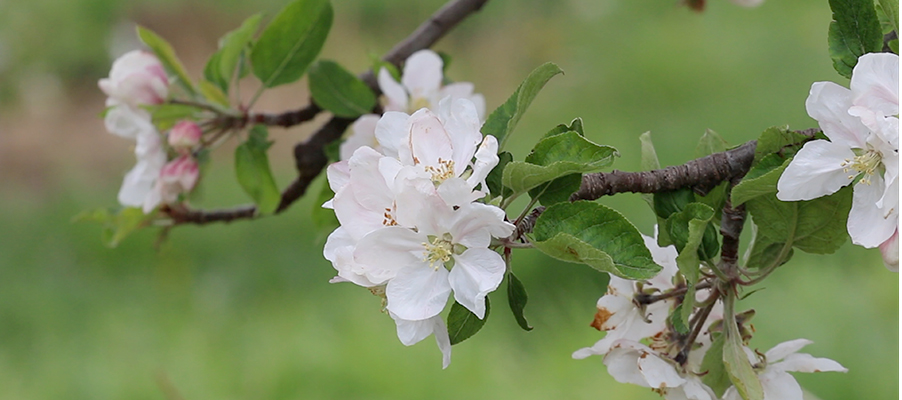
Behold! Persephone has arisen. She is risen indeed.
Persephone, beloved daughter of Zeus and Demeter, has escaped her abductor Hades, brother of Zeus—again. Her mother, Demeter—daughter of Cronus and Rhea, and goddess of grain—rejoices.
It’s spring.
Demeter lifts her curse from the soil. Earth blossoms. Trees bud. Fruits, nuts, grains, and berries will soon burst forth.
Sing choirs of angels! Sing in adoration!
Let us eat, drink, and be merry today, for come winter Persephone will cross over the River Styx into the realm of the dead—again.
It’s an old story. The origins are fuzzy. But the power of the story is clear: It gives hope to people living through bleak winter seasons.
Persephone stands for the victory of life over death, of hope over despair.
We may call it a myth, but ancient peoples did not distinguish between logos and mythos as we do. Logos and mythos were nearly the same. The resurrection of Persephone explained natural cycles. Period.
The resurrection of Jesus explains something else, something of human nature. According to the gospel story, several distraught women trudged through a garden to the tomb. They were not heartened by the signs of spring that morning. They were heartened by the appearance of Jesus, the one who loved his enemies to death.
That’s not natural.
Many Roman, Greek, Babylonian, and Egyptian myths explain natural phenomena. The world didn’t need another myth like that. The world needed something else—a story of hope in the face of human injustice and cruelty.
Can humans come back from catastrophic defeat with a spirit of resolute defiance and courage?
Yes, we can. Yes, we have.
The resurrection of Jesus tells that story. It’s situated in a certain time and place, but, like other myths, it is timeless.
Over and over again, in the wake of a martyr’s death—John Hus, Joan of Arc, John Brown, Gandhi, Martin Luther King—a body arises to continue the work. In the wake of Jesus’s death, a body arose. No, not the singular body of Jesus (dead bodies do not come back to life) but a body of people carrying on the work of Jesus—welcoming outcasts, feeding the hungry, healing the sick, soothing the tormented, refusing weapons—at least until they embraced the Empire, sought power and glory, and forsook the way of love.
That killed Jesus for good.
Or did it?
_______________________
See Paula’s “Peaches & Daffodils” on the home page. Posted March 26, 2023




Amen. You just blessed my Easter with Love, Truth, and Beauty. Thank you. May yours feel as blessed.
Appreciating the clarification about Easter. And also, recently learned that one in 20 Americans owns an assault weapon, so that must mean that 19 refuse to own one. We carry on.
Demeter raised the curse – the bleeding heart in my flower bed is bursting through the soil. So happy to see this again THIS spring.
What a brilliant, succinct and inspirational summary! The mystical symbolism of Easter, especially the empty tomb and the possibility of a full life, has haunted me with hope. It is not about a dead body coming alive, but people carrying on the work of love, compassion and justice. As Frederick Buechner noted, “Resurrection means that the worst thing is never the last thing.”
It’s Easter Sunday and I have arisen—from my bed. The sun is out, red buds blooming, trees are greening. What a blessing—Thank you Cosmos!
On this day of rejoicing, I am particularly thankful for paramedics and EMTs. Three times in the last month, my son Scott, a paramedic himself, descended to the land of no pulse when his heart gave out. Three times he HAPPENED to be with EMS relatives and friends who brought him back. And thanks to his wife McKenzie–a living breathing Persephone if there ever was one–he is alert and in good care at Wake Med in Raleigh.
EMS providers are more stressed now than ever, even post pandemic. They are not only short-staffed, but short of ambulances. The North Carolina county Scott serves is 13 ambulances short–they can’t get parts for the old ones or get new ones in. That means a lot of “unsuccessful” calls–if they get there at all. “Success” for EMS professionals means more than quotas or dollar signs or poll numbers. It means someone lives–or not. Please support your local EMS providers in whatever way you can. They put their heart into every call.
Our world is flooded with light and life. It is a renewing and a chance for us to take part and open our lives to the light and life Thank you as ever.
Yep! You nailed it. Pun intended. I’m tracking with you. JF
I was not there. A bell ringer I know said she thinks it happened. While the choir, bell ringers, and pianist did their thing, 3 ladies from the congregation were to reenact the discovery of the rolled away stone. But it happened behind and not in front of the singers and musicians. But they are confident in what was supposed to have happened, did indeed happen.
The canonized account was authored by John Mark or Anonymous, experts say. He wrote in Greek with Gentiles being the primary targeted audience. The goal was to strengthen the Faith. Also, some claim Mark was the founder of the Coptic Church in Egypt, believed to have been martyred, dragged by a horse at the hands of pagans on Easter, 68 A.D. in Alexandria.
I wasn’t there. I score mythos the winner by a stone’s throw.
“Roll away the stone, Don’t leave me here alone, Resurrect me and protect me, Don’t leave me laying here, What will they do in two thousand years?” Leon Russell “Roll Away the Stone”
Yet another crate of “religious misinformation” pushed off the freight car. Thanks.